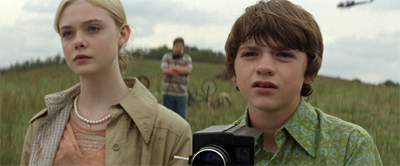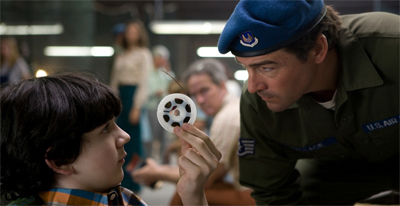Super 8 is a love letter to film. It’s an ode to the trashy, forgettable – yet still endearing – stuff, like a bunch kids screwing around with an obvious fixation on the work of George A. Romero. It’s also a sweet tribute to the film that emotionally connects with us, like the footage of a long lost relative projected against a wall, almost convincing us for a second that they’re still with us. JJ Abrams might consciously evoke early Spielberg with his style, but it’s only to celebrate the common ground they both share, the believe that film is truly powerful and emotion medium, one that strikes a chord on the most improbable of notes, teaching us life lessons and engaging us in nothing short of magic. The posters and trailers might convince you that Super 8 is a classic monster movie with seventies trappings – and it is – but it’s also that other difficult-to-get-quite-genre, the coming-of-age tale. Just one that features giant monsters.
The film follows the escape of a strange creature from a late-night train derailed in a small town. Mysterious and ominous things begin to happen, and the military is quickly on the scene, protesting that there’s nothing to see here. At the same time, a bunch of local kids are producing a surprising similar film about monsters loose in a small town, and the powers that be attempting to deny their existence. However, this is the story of Joe Lamb, a little boy who recently lost his mother. As much as Abram’s technical skill – as demonstrated here and elsewhere – may dazzle, it’s his knack for drawing genuine emotion that makes the story work so well.
The movie is about Joe coming to terms with the tragedy, and also growing to understand the world around him. In that wonderful sense of Spielbergian symmetry, it’s a journey Joe shares with the monster of the piece, trying to understand the world as it is. The interactions of the adults around him (the relationship between his father and a man who worked with his mother, or even his father and the military platoon stationed in the town) begin as something of a mystery to Joe, and to the audience. We only see brief interactions, flurries of movement, overhearing snippets of conversation. Then, through the course of the film, like a child growing up, we begin to see more. Along with Joe, we come to various realisations about this world and the people who inhabit it. The grouchy old Dr. Woodward is no longer just the local honours biology teacher, he’s something far more complex. People we thought were villains live with their own demons. Those we thought were disinterested are doing their very best under the very tough circumstances to protect those who rely on them.
And through all this, the medium of choice is film. Joe connects with his dead mother via old footage he keeps. The boys dig into the mountains of files Dr. Woodward meticulously kept, but we glean most of the information we need through video footage and his own recorded personal logs – the combination of sound and vision, uniting to give us one clear story. Setting the story in the late seventies, Abrams even evokes the period through cinema. There’s a heavy Steven Spielberg influence on the story, and it’s hard not to think of E.T. while watching various parts of the movie. Cinema is a shared cultural experience, both amongst those who make it and those who enjoy it. Abrams seems to suggest the two feed into one another, with the local kids hoping to produce a zombie homage, while Abrams himself provides a lovely Spielberg homage.
That’s not to say that Abrams doesn’t leave his own mark on things. The director’s trademark awareness is found in every frame, as he even goes to pains to articulate a lot of what his audience must be thinking, as if acknowledging various plot devices makes them more palatable. The token adult, who has ferried the kids to where they need to be, is told not to follow the group on a completely reckless and dangerous little excursion. Instead, having served his plot function, he just sits there and lets them do the risky stuff. “So what?” he asks, “I just sit here in the car like a douche?” Later on, captured by the military, one of the kids asserts that they’re safe from any real danger, “because we’re chil-“I won’t tell you what cuts it off, but demonstrating his awareness of these cinematic tropes does a lot towards convincing the audience that anything can happen. This isn’t a director following the rules because he doesn’t know how to do anything else, he’s following them because he knows how to use them. And how to toy with them if needed.
And yet the story is never cynical. At the heart of the tale is a wonderfully uplifting moral about what makes us human. “Bad things happen, but you can still live.” It’s a lesson that we all need to learn at some point, and coming to terms with it is just part of growing up. It’s that sort of observation on the human condition, that never gets lost amid the special effects work or the action sequences, that sets the movie clearly apart from most other summer blockbusters. It’s never overwrought or cheesy, but Abrams doesn’t hide his observations behind a layer of cool cynicism.
Working with children is always a risky proposition, especially if you’re going to rest the film on a bunch of them. Finding one kid who can act is a tough enough task, and its to Abram’s credit that he managed to track down a whole team of them. The young actors give great performances, and special mention must go to Elle Fanning, who is simply phenomenal as Alice. That’s not to say that the rest of the bunch don’t impress, merely that Fanning is simply outstanding.
Speaking of outstanding, the sound design is jaw dropping. During the film’s first action sequence, in a crowded cinema, the teeth were rattling in my head, and I honestly think that the visuals wouldn’t have been nearly as effective without the careful expertise put into the sound. Michael Giacchino provides a wonderful soundtrack which really does evoke the epic, sweeping scores of yesteryear. The film simply sounds amazing, and it synchs up perfectly with Abrams’ vision. I don’t normally notice sound design, but here it is truly spectacular.
There’s been a lot of talk about whether Super 8 is the film of the year. I think it’s still too early to say, but – as of right now – it’s on a very short list of contenders. If you consider yourself a fan of cinema, and if you harbour an affection for those old coming-of-age stories that we haven’t seen handled in the same since the eighties, you owe to yourself to see this on the big screen. I’m sure it’ll be impressive on the small screen, and still be an excellent motion picture, but it would be a shame to see this love letter to film anywhere but a cinema.
Filed under: Non-Review Reviews | Tagged: Elle Fanning, film, george a. romero, J. J. Abrams, jj abrams, Joe Lamb, Michael Giacchino, Movie, non-review review, review, steven spielberg, super 8, Super 8 mm film |
























I would love to see it again in theaters but I suppose I’ll settle for when “Super 8” to comes out on Blu-ray. I’m in the process of upgrading my “home theater” at the moment and I’m imagining how fun some of these summer releases will be with a more comfortable chair to sink into and free concessions.
Has “Cowboys and Aliens” hit your side of the pond yet?
Not yet, think it’s about two weeks away.